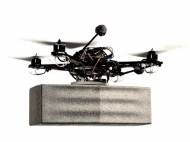Using robots to construct buildings
 With each day, robots are becoming more popular and affordable, and they find new applications in various fields such as aid in manual labor or entertainment. Robots use in architecture hasn’t been around aside performing such tasks in video games and science fiction, but professorship of Gramazio & Kohler plans to change that fact and turn those ideas into reality.
With each day, robots are becoming more popular and affordable, and they find new applications in various fields such as aid in manual labor or entertainment. Robots use in architecture hasn’t been around aside performing such tasks in video games and science fiction, but professorship of Gramazio & Kohler plans to change that fact and turn those ideas into reality.
Two professors of architecture at ETH Zurich, Fabio Gramazio and Matthias Kohler, decided to conceive spatial relationships and contextual behavior through programming instead designing architecture solely by drawing. They conduct various projects which involve application of robots in building construction as well, and in this article we’re going to write about two of their project.
In one of their current research projects, they are exploring the potential of industrial robots that could be used on construction sites or robotic prefab factories. Named dimRob – robotics on construction site, the project involves development of robot’s ability to recognize its own position, the surroundings and its components with regard to the material tolerances.
ETH Zurich researchers collaborated with Bachmann Engineering AG and developed a low weight robotic system with relatively compact size that could squeeze through a standardized door frame on construction sites. ABB IRB 4600 (2.55) industrial-robot, which provides wide operational range, is mounted on a diesel engine powered compact mobile track system with integrated raising jacks.
An innovative scanning system enables the robot to orient itself and simultaneously process the information about the manipulated materials and surrounding environment. A powerful laser measurement system (Sick LMS 500) was installed on the robot’s arm in order to detect of tolerances and two vacuum grippers enable the robot to take single bricks at high speed and to position them with high precision.
The robot can import data from existing CAD software via developed plug-in. It enables the CAD design to be exported to the programming language of the robot. The researchers plan to refine this process in order to enable to more efficient workflows and broader applications.
In their other project, Gramazio & Kohler collaborate with Raffaello D’Andrea, developer of autonomous systems design and algorithms, in order to develop automated airborne assembly. Named Flight Assembled Architecture, the project involves development of an automated assembly apparatus which relies on simultaneous use of multiple flying robots.
Considered as tools for adaptive production, these quadricopter flying robots are programmed to interact and pick up modules in order to transport and assemble them into architectural structures. The project builds on the simultaneous use of multiple mobile agents.
In order to demonstrate their idea, they are using small quadricopters to build a 1:600 scaled “vertical village” of 600 meters. The flying robots used 1500 prefabricated polystyrene foam modules to assembly a model which is 6 m high and has 3.5 m in diameter. The Flight Assembled Architecture project and mentioned structure are exhibited until the February 19, 2012 at the FRAC Centre in Orléans, France.









It’s good to see these ides being realized.
Although it might lead to even less employment in one of the areas which still employs workers with low classifications, but so did the car manufacturers and many other factories.
Once these achieve the state of real world application, I assume they could be used in hazardous or remote areas where they could operate non-stop.